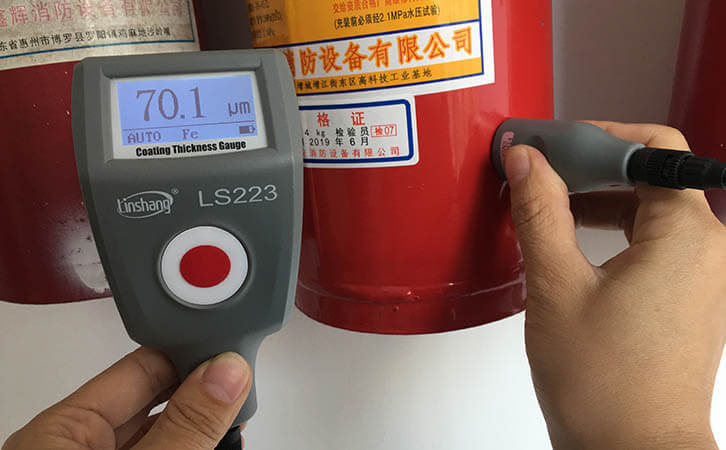Difference between Steel Structure Anticorrosive Coating and Fireproof Coating
The thickness requirements and coating thickness detection methods of these two coatings are also introduced. Although the two coatings of fire-resistant coating and anti-corrosion coating are used to protect steel structural members from being damaged by some external factors, the emphasis of these two coatings is completely different. There are both differences and connections. The difference between them has resulted in two completely different coating purposes for fire protection coatings and anticorrosive coatings. Due to the connection between them, some coatings with both functions are produced, that is, coatings with both fire and corrosion protection. These two coatings usually have coating thickness requirements. We generally use an anticorrosive coating thickness gauge to measure their thickness.
First of all, let's take a look at pure fire-resistant coatings. We must know that pure fire-resistant coatings do not mean that it has no anti-corrosion ability at all, but that the anti-corrosion ability of this kind of paint is very weak or even be ignored. The fire-resistant coatings on steel structures delay the rate of heat transfer to the protected substrate relying on the low thermal conductivity of the coating. In addition, it is necessary to know that the coating applied on the substrate is not combustible. It can play two roles of preventing fire and radiation on the steel structure.
In general, the thickness of fire-resistant coatings is usually relatively thick and even a few millimeters of thickness on steel structure coatings is very normal. For those non-intumescent fire-resistant coatings, steel structure surface coating is coated with anticorrosion. Coating thickness measured by coating thickness gauges can even reach 50mm. We only need to construct a thin anticorrosive coating under the fireproof coating would be suitable in most places. In general, the anticorrosive coating only needs a dry film thickness of 200 μm to achieve the expected anticorrosive effect.
1. Pure anticorrosive coating
The fire resistance of pure anticorrosive coatings is completely negligible, mainly because they only need to apply a film thickness of hundreds of microns on steel structures to achieve the desired anticorrosive effect. But we must know that such film thickness is completely unsatisfactory. Although the thin coating type fire retardant coating is very low, the pure anticorrosive coating will expand after being heated. The thickness of the expanded pure anticorrosive coating will increase several times, so to a certain extent, it can actually increase a little effect of fire insulation. But they exist only to prevent corrosion.
2. Coatings with both fire and corrosion protection
When the steel structure has relatively low requirements for the fire-resistant time limit, then its film thickness requirements for fire-resistant coatings will also decrease. For example, a fire-resistant coating with a fire resistance time of half an hour. As long as its film thickness can be measured with an anti-corrosion coating thickness gauge to reach 300 μm, the expected effect can be achieved. In this case, it is significantly more economical to use fire-resistant and anti-corrosive dual-functional coatings. Under normal circumstances, it can protect steel from corrosion. In the event of a fire, this coating will also expand, thereby increasing the film thickness several times or even dozens of times to achieve fire resistance.
3. Fire and anticorrosion coating thickness detection
The coating thickness is an important indicator of whether the anticorrosive coating works. The coating thickness is one of the most important quality inspection indicators of an anti-corrosion coating. For anti-corrosion coatings, coating thickness gauges are almost essential tools for coating thickness measurement. The coating has been applied in various industries at present and the detection is convenient. The instrument has developed into various types such as magnetic induction, ultrasonic, eddy current.
LS221 coating thickness gaugeis also called film thickness gauge, which is a professional instrument for measuring the thickness of metal surface coatings. This coating thickness gauge uses the principle of Hall effect and eddy current effect to accurately measure the thickness of non-magnetic coatings on ferromagnetic metal substrates and the thickness of non-conductive coatings on the non-magnetic metal substrates. It is a dual-use coating thickness gauge which can be used for both iron and aluminum. Linshang coating thickness gauge is widely used in metal processing industry, hardware industry, shipbuilding industry, aerospace industry and other fields.
Linshang anti-corrosion coating thickness gauge LS223 recommended reasons:
● Using dual-function measurement technology, it can automatically identify magnetic or non-magnetic substrates and quickly complete automatic conversion in 0.5 seconds.
● The advanced digital probe technology can keep the zero position stable for a long time without drifting.
● The new lightweight design of the body makes it easy to carry around.
● Advanced technology solves the problem of linearity in the full range. Just zero adjustment is needed to ensure the measurement accuracy.
● High-sensitivity probe, the test response speed is very fast, the data can be measured in 0.5 seconds.
● The coating thickness gauge has temperature compensation technology to ensure the measurement accuracy of the instrument at different ambient temperatures, which can also be used at minus 20 ° C.
● The probe tip is fixed with expensive ruby to ensure that the instrument will not cause probe wear for long-term testing and prolong the service life.
● Negative number display function to ensure the accuracy of the zero calibration and improve the test accuracy.
● Low power design, less than 0.01 micros of current in standby mode.
- High precision coating thickness gauge for used car
- Automotive paint protection films coating thickness gauge
- Plating Thickness Measuring Instrument for Detecting Anti-corrosion Coating
- Linshang LS220, LS191, LS160A– Necessary for Car Cover Inspection
- Coating Thickness Gauge for Second Hand Vehicle
- Zero Adjustment Step of Coating Thickness Gauge
